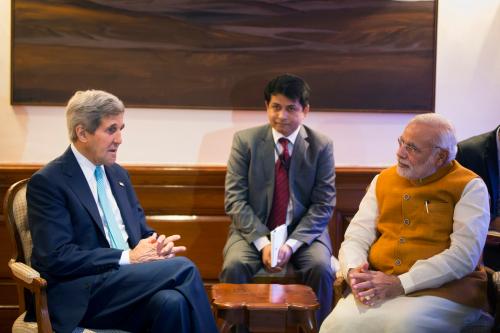Content from the Brookings Institution India Center is now archived. After seven years of an impactful partnership, as of September 11, 2020, Brookings India is now the Centre for Social and Economic Progress, an independent public policy institution based in India.
When Prime Minister Narendra Modi and President Barack Obama met for their first summit in September 2014 in Washington DC, they had a crowded and diverse agenda ranging from terrorism to trade and a spate of other issues. This reflected the sheer breadth of the India-U.S. relationship, but the agenda also included many issues – such as the stalled civil nuclear deal – that remain unresolved and have become symptomatic of the drift in the relationship. And the shadow of the past threatened to cloud the prospects for the future.
The Modi-Obama Summit: A Leadership Moment for India and the United States, a briefing book with memos by Brookings experts in New Delhi and Washington, issued on the eve of the first summit, highlighted some of the challenges and opportunities for both leaders and offered ways to move forward on a number of issues facing both countries.
Both leaders did seize the leadership moment that the first summit provided to give momentum and outline the future contours of the India-U.S. relationship. This was apparent in their joint Washington Post op-ed, “A Renewed U.S.-India Partnership for the 21st Century,” a vision statement and the ambitious joint declaration, which called for consultations on global and regional issues, as well as a bilateral focus on economic growth, energy and climate change, defense and homeland security, and high technology, space and health cooperation. The New Delhi summit – their second in less than six months – is an ideal opportunity to build on that joint vision.
The India-U.S. relationship is evolving against the backdrop of growing global disorder. A recalcitrant Russia, a resurgent China and a fragile and vulnerable Afghanistan pose challenges to both India and the United States. Additionally a series of ‘black swan’ events – from the dramatic and brutal rise of Islamic State, to the precipitous fall in oil prices, and the inability to curtail the Ebola outbreak – revealed how ill prepared nations, including India and the United States, are to deal with them.
With the upheaval wrought by state and non-state actors to its west and inter-state tensions to its east, India sits at the epicenter of the unfolding geopolitical uncertainty; New Delhi might have no choice but to help manage the chaos and restore order regionally and globally for its own interest. There is growing recognition in the Modi government that the United States is probably the best partner to address these challenges and help India’s rise—despite the differences that persist between the two countries and the questions about reliability. The Obama administration, on its part, has repeatedly stated that even if India and the United States will not always be on the same page, India’s rise is in U.S. interest—not least because a strong, prosperous, inclusive India could help manage global and regional disorder.
Even before the second summit, a spate of high-level visits and consultations on trade disputes, intellectual property rights, defense cooperation, civil nuclear cooperation, clean energy and climate change, and infrastructure investment indicated the serious efforts that have been ongoing to clear the backlog of hurdles and pave the way for enhanced cooperation in the future. However, given the sheer complexity of some of these issues, coupled with the lack of trust between the two bureaucracies and the entrenched interests on both sides, it is unlikely that all of them will be resolved by the summit.
Nonetheless, it would be crucial for President Obama and Prime Minister Modi to ensure that despite this the relationship continues to deepen and widen.
This briefing book analyses some crucial geopolitical and geoeconomic issues that directly affect India and the U.S., as well as their relationship with each other. Additional memos examine the progress made in implementing elements in the joint declaration and focus on a range of issues on which India and the U.S. are or need to be cooperating, including in the foreign, security, economic, energy, urban and social policy realms.
However, a successful summit is only as good as the ability to deliver on the promises made. Here, both Prime Minister Modi and President Obama face challenges in their ability to deliver on potential summit commitments.










